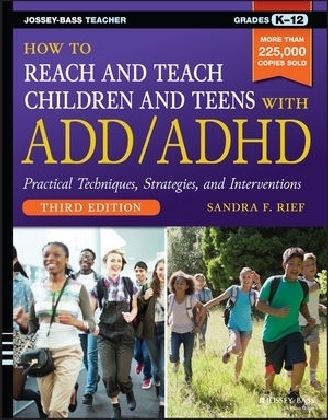
How to Reach and Teach Children and Teens with ADD/ADHD
John Wiley & Sons Inc (Verlag)
978-1-118-93778-5 (ISBN)
The most up-to-date and comprehensive vital resource for educators seeking ADD/ADHD-supportive methods How to Reach and Teach Children and Teens with ADD/ADHD, Third Edition is an essential guide for school personnel. Approximately 10 percent of school-aged children have ADD/ADHD—that is at least two students in every classroom. Without support and appropriate intervention, many of these students will suffer academically and socially, leaving them at risk for a variety of negative outcomes. This book serves as a comprehensive guide to understand and manage ADHD: utilizing educational methods, techniques, and accommodations to help children and teens sidestep their weaknesses and showcase their numerous strengths. This new 2016 edition has been completely updated with the latest information about ADHD, research-validated treatments, educational laws, executive function, and subject-specific strategies. It also includes powerful case studies, intervention plans, valuable resources, and a variety of management tools to improve the academic and behavioral performance of students from kindergarten through high-school. From learning and behavioral techniques to whole group and individualized interventions, this indispensable guide is a must-have resource for every classroom—providing expert tips and strategies on reaching kids with ADHD, getting through, and bringing out their best.
Prevent behavioral problems in the classroom and other school settings
Increase students' on-task behavior, work production, and academic performance
Effectively manage challenging behaviors related to ADHD
Improve executive function-related skills (organization, memory, time management)
Apply specific research-based supports and interventions to enable school success
Communicate and collaborate effectively with parents, physicians, and agencies
SANDRA RIEF, M.A., is an internationally known author, speaker, and educational consultant, specializing in practical and effective strategies for helping students with ADHD and learning disabilities succeed in school. She is the author or coauthor of The ADHD Book of Lists, The Dyslexia Checklist, The ADD/ADHD Checklist and other books, all published by Jossey-Bass.
Preface xxv
PART 1: KEY INFORMATION FOR UNDERSTANDING AND MANAGING ADHD
Section 1.1: Understanding ADHD 3
Section 1.2: ADHD and Executive Function Impairment 21
Section 1.3: Making the Diagnosis: A Comprehensive Evaluation for ADHD 27
Section 1.4: Multimodal Treatment for ADHD 35
Section 1.5: Medication Treatment and Management 43
Section 1.6: Behavioral Therapy for Managing ADHD 51
Section 1.7: Critical Factors in the Success of Students with ADHD 57
Section 1.8: ADHD in Preschool and Kindergarten 63
Section 1.9: ADHD in Middle School and High School 73
PART 2: MANAGING THE CHALLENGE OF ADHD BEHAVIORS
Section 2.1: Proactive Classroom Management 97
Section 2.2: Preventing Behavior Problems during Transitions and Less Structured Times 111
Section 2.3: Class (Group) Behavior Management and Incentive Systems 115
Section 2.4: Individualized Behavior Supports and Interventions 123
Section 2.5: Strategies to Increase Listening, Following Directions, and Compliance 139
Section 2.6: Managing Challenging Behavior: Strategies for Teachers and Parents 143
Section 2.7: School-Based Social Skills Interventions 153
PART 3: INSTRUCTIONAL, LEARNING, AND EXECUTIVE FUNCTION STRATEGIES
Section 3.1: Attention!! Strategies for Engaging, Maintaining, and Regulating Students’ Attention 177
Section 3.2: Research-Based Instructional Approaches and Interventions 191
Section 3.3: Organization and Time Management 207
Section 3.4: The Homework Challenge: Strategies and Tips for Parents and Teachers 219
Section 3.5: Learning Strategies and Study Skills 229
Section 3.6: Memory Strategies and Supports 237
PART 4: STRATEGIES AND SUPPORTS FOR READING, WRITING, AND MATH
Section 4.1: Common Reading and Writing Difficulties 257
Section 4.2: Decoding, Fluency, and Vocabulary 267
Section 4.3: Reading Comprehension 277
Section 4.4: Writing: Strategies, Supports, and Accommodations 291
Section 4.5: Spelling and Handwriting 309
Section 4.6: Mathematics 319
PART 5: PERSONAL STORIES AND CASE STUDIES
Section 5.1: A Parent’s Story . . . What Every Teacher, Clinician, and Parent of a Child with ADHD Needs to Hear 343
Section 5.2: Student Case Studies and Interventions 375
PART 6: COLLABORATIVE EFFORTS AND SCHOOL RESPONSIBILITIES IN HELPING STUDENTS WITH ADHD
Section 6.1: Teaming for Success: Communication, Collaboration, and Mutual Support 389
Section 6.2: The Role of the School’s Multidisciplinary Team 399
Section 6.3: School Documentation and Communication with Medical Providers and Others 407
Section 6.4: Federal Laws and Educational Rights of Students with ADHD 415
APPENDIX: FORMS 433
A.1: ___’s Daily Report 434
A.2: My Behavior Report 435
A.3A: Daily Report 436
A.3B: Daily Report Card 437
A.3C: Daily/Weekly Report Card 438
A.3D: Daily Behavior Report 439
A.4: Daily Monitoring Report 440
A.5: Self-Monitoring Behavior Log 441
A.6: Notebook Check 442
A.7: Homework Assignments 443
A.8: Homework Tracking Sheet 444
A.9: Book Club Roles 445
A.10: Book Club Culminating Activities 447
A.11: Five-Paragraph Persuasive Essay Rubric 449
A.12: Research Log 450
INDEX: 451
| Erscheinungsdatum | 04.10.2016 |
|---|---|
| Verlagsort | New York |
| Sprache | englisch |
| Maße | 216 x 274 mm |
| Gewicht | 953 g |
| Themenwelt | Sozialwissenschaften ► Pädagogik ► Sonder-, Heil- und Förderpädagogik |
| ISBN-10 | 1-118-93778-3 / 1118937783 |
| ISBN-13 | 978-1-118-93778-5 / 9781118937785 |
| Zustand | Neuware |
| Informationen gemäß Produktsicherheitsverordnung (GPSR) | |
| Haben Sie eine Frage zum Produkt? |
aus dem Bereich


